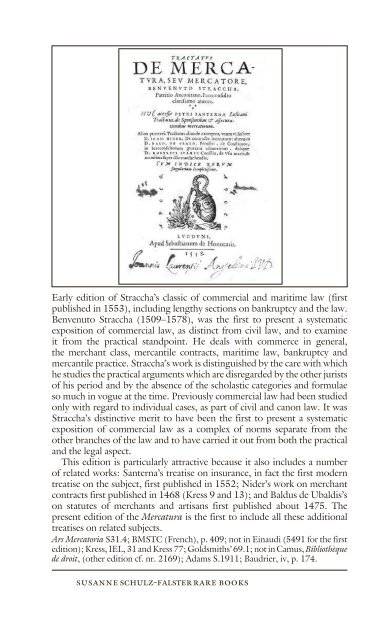Susanne Schulz-Falster Catalogue Eighteen - International League ...
Susanne Schulz-Falster Catalogue Eighteen - International League ...
Susanne Schulz-Falster Catalogue Eighteen - International League ...
You also want an ePaper? Increase the reach of your titles
YUMPU automatically turns print PDFs into web optimized ePapers that Google loves.
Early edition of Straccha’s classic of commercial and maritime law (first<br />
published in 1553), including lengthy sections on bankruptcy and the law.<br />
Benvenuto Straccha (1509–1578), was the first to present a systematic<br />
exposition of commercial law, as distinct from civil law, and to examine<br />
it from the practical standpoint. He deals with commerce in general,<br />
the merchant class, mercantile contracts, maritime law, bankruptcy and<br />
mercantile practice. Straccha’s work is distinguished by the care with which<br />
he studies the practical arguments which are disregarded by the other jurists<br />
of his period and by the absence of the scholastic categories and formulae<br />
so much in vogue at the time. Previously commercial law had been studied<br />
only with regard to individual cases, as part of civil and canon law. It was<br />
Straccha’s distinctive merit to have been the first to present a systematic<br />
exposition of commercial law as a complex of norms separate from the<br />
other branches of the law and to have carried it out from both the practical<br />
and the legal aspect.<br />
This edition is particularly attractive because it also includes a number<br />
of related works: Santerna’s treatise on insurance, in fact the first modern<br />
treatise on the subject, first published in 1552; Nider’s work on merchant<br />
contracts first published in 1468 (Kress 9 and 13); and Baldus de Ubaldis’s<br />
on statutes of merchants and artisans first published about 1475. The<br />
present edition of the Mercatura is the first to include all these additional<br />
treatises on related subjects.<br />
Ars Mercatoria S31.4; BMSTC (French), p. 409; not in Einaudi (5491 for the first<br />
edition); Kress, IEL, 31 and Kress 77; Goldsmiths’ 69.1; not in Camus, Bibliothèque<br />
de droit, (other edition cf. nr. 2169); Adams S.1911; Baudrier, iv, p. 174.<br />
Skirts Neither Too Short Nor Too Long<br />
susanne schulz-falster rare books catalogue eighteen<br />
102. [SUMPTUARY LAWS.] Provisione Reformata sopra le<br />
Pompe, e Vestire cosi delle Donne come de gli Huomini, Apparati<br />
di Doti, & de Banchetti. Publicata alli vij & reiterrata alli viii di<br />
Genaro 1574. Bologna, Alessandro Benacci, 1574. £750<br />
4to, pp. [viii]; three heraldic woodcuts to title page, decorative initial;<br />
slight browning due to paper stock; folded, unbound as issued; a little<br />
dog-eared.<br />
First edition of rare sumptuary laws regulating dress and ornaments of the<br />
inhabitants of Bologna, in fact a revision of the laws promulgated in 1572.<br />
The dress code of women attracts particular attention, skirts are meant to<br />
be neither too long, nor too short, jewellery is to be worn in moderation.<br />
A single-strand pearl necklace is acceptable, unless it is too long – and<br />
variations apply depending on whether a woman is married or not. Special<br />
exceptions are made for weddings, but even then the social order needs to<br />
be upheld, and women have to be dressed according to rank and status.<br />
Contravention of the detailed rules leads to fines, which increase for repeat<br />
offenders.<br />
BL has 1560 edition, no others in OCLC.
















